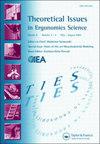The importance of incorporating risk into human-automation trust
IF 1.4
Q4 ERGONOMICS
引用次数: 9
Abstract
Abstract A key psychological component of interactions in both human-human and human-automation relationships is trust. Although trust has repeatedly been conceptualized as having a component of risk, the role risk plays, as well as what elements of risk impact trust (e.g., perceived risk, risk-taking propensity), has not been clearly explained. Upon reviewing the foundational theories of trust, it is clear that trust is only needed when risk exists or is perceived to exist, in both human-human and human-automation contexts. Within the limited research that has explored human-automation trust and risk, it has been found that the presence of risk and a participant’s perceived situational risk impacts their behavioural trust of the automation. In addition, perceived relational risk has a strong negative relationship with trust. We provide an enhanced model of trust to demonstrate how risk interacts with trust, incorporating these distinct perceived risks, as well as risk-taking propensity. This model identifies the unique interactions of these components with trust based on both the theory reviewed and the studies that have explored some aspects of these relationships. Guidelines are provided for improving the study of human-automation trust via the incorporation of risk.将风险纳入人类-自动化信任的重要性
摘要人与人之间以及人与自动化关系中互动的一个关键心理组成部分是信任。尽管信任一再被概念化为具有风险的一个组成部分,但风险所扮演的角色,以及风险的哪些因素(如感知风险、冒险倾向)对信任的影响,都没有得到明确的解释。在回顾信任的基本理论后,很明显,只有在人类和人类自动化环境中存在或被认为存在风险时,才需要信任。在探索人类自动化信任和风险的有限研究中,发现风险的存在和参与者感知的情境风险会影响他们对自动化的行为信任。此外,感知到的关系风险与信任有着强烈的负向关系。我们提供了一个增强的信任模型来证明风险如何与信任相互作用,包括这些不同的感知风险以及冒险倾向。该模型基于所回顾的理论和探索这些关系某些方面的研究,确定了这些组成部分与信任的独特相互作用。提供了通过纳入风险来改进人类自动化信任研究的指南。
本文章由计算机程序翻译,如有差异,请以英文原文为准。
求助全文
约1分钟内获得全文
求助全文

 求助内容:
求助内容: 应助结果提醒方式:
应助结果提醒方式:


